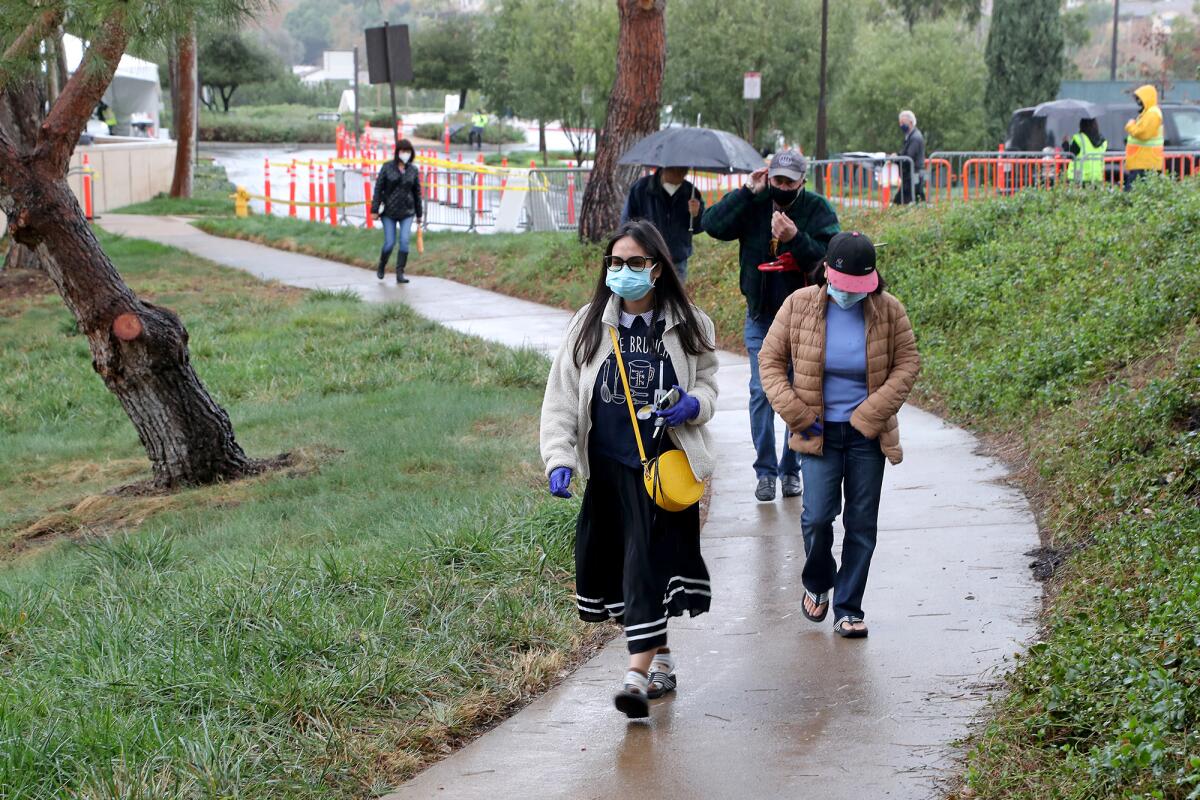O.C. turns to community health centers for more equity in distributing COVID-19 vaccines
- Share via
Though the Latino community has taken the brunt of the pandemic in Orange County, the population only accounts for 12% of the people who have received at least one vaccine dose in the county.
There have been concerns that the county hasn’t adequately included underserved communities in its vaccine distribution plans, which focus on mass sites called Super PODs at Disneyland, Soka University and the soon-to-be site at the Anaheim Convention Center.
According to state data, the Latino population makes up about 35% of the county’s population but accounts for 49% of the county’s COVID-19 cases.
White people account for about 28% of the county’s COVID-19 cases, yet make up 48% of the recipients of at least one dose of a vaccine in the county, according to county data.
“I think that the original intent to create Super PODs was to increase the volume of vaccines that were distributed,” said Isabel Becerra, chief executive of the Coalition of Orange County Community Health Centers. “I don’t think that they anticipated that it would be as hard as it has been for the low-income communities and underserved communities to reach these PODs.”
Becerra believes the county is moving in the right direction with the opening of a new vaccination site this week at Santa Ana College and a commitment from the county to work with community health clinics.
The county recently provided the Coalition of Orange County Community Health Centers with an initial amount of 15,000 vaccine doses.
“I just think there’s no other way that you can 100% guarantee that vaccines are going where they need to be unless you work with the community health in your region because that is why community health centers exist in the first place,” Becerra said.
Ellen Ahn, executive director of Korean Community Services, said community health clinics are “embedded” in the communities they serve.
“All of us community health centers we have different niche populations we work with, and we’re experts in those populations,” Ahn said. “... I think that that decision by the Health Care Agency was a smart one. Why reinvent the wheel if you already have folks that can address the equity issues?”
Orange County will suspend distribution of the COVID-19 vaccine at its Disneyland Super POD site in Anaheim through at least Monday, while a new vaccination site at Santa Ana College will close on Saturday.
The coalition, made up of 23 health centers, may receive more doses on an ongoing basis, though it is dependent on vaccine availability and the ability of the coalition members to administer the vaccine in a timely manner.
Becerra said the coalition has to use at least 65% of the vaccines per week to receive a weekly allotment of 15,000 vaccines.
“In other words, we can’t sit on them,” Becerra said. “The minute we get them, we have to distribute them and we can absolutely do that.”
The county was less forthright in discussing the 15,000-per-week allotment.
Dr. Margaret Bredehoft, the county’s deputy agency director of Public Health Services, said in an email the allocation of the 15,000 doses is part of the county’s plan to get more vaccines to underserved populations, however, there is no “official agreement” between the county and the coalition for ongoing vaccines.
“Currently we are focusing on addressing equity and ensuring access for vulnerable populations,” Bredehoft said. “The county has been addressing the needs of Latino population by hosting smaller PODs and has most recently announced a location at Santa Ana College that will be specifically for residents in Anaheim and Santa Ana — two of the hardest-hit communities.”

Before a community clinic receives vaccines from the county, they are required to be approved by the state through CalVAX, demonstrate a plan for dispensing the vaccine doses within seven days and provide proper storage and handling of the vaccine.
The coalition will use a “hub and spoke” model to distribute the vaccine. Because maintaining the integrity of the Pfizer vaccine requires a special freezer, only five of the clinics in the coalition will be able to store the vaccine. These clinics will act as hubs. They will then disseminate the vaccine to other clinics within the coalition.
Becerra said much of the vaccine administration is done at the clinics, and many of the clinics have transportation to bring patients to and from appointments. The coalition will also bring mobile units to vaccinate at Latino Health Access sites, senior citizen centers and local elementary schools.
Becerra said they are predominately receiving the Pfizer vaccine due to low supply of the Moderna vaccine.
“The Health Care Agency is allocating a portion of the county’s vaccine supply to more than 70 healthcare providers throughout the county, including community clinics,” Bredehoft said. “As vaccine supply increases, we will be able to provide more vaccine to more providers.”
Jay Lee, chief medical officer with Share Our Selves, said his clinic will be working with a hub because it doesn’t have one of the special freezers needed for the Pfizer vaccine.
Share Our Selves has clinics in Costa Mesa, Santa Ana, Newport Beach and Mission Viejo. It serves about 16,000 patients.
Lee said the Pfizer vaccine poses a number of logistical issues for the clinics. He said once his clinic receives doses from the hub, they will need to be administered within about six hours after the vaccine thaws.
“The characteristics of the vaccine and level of quickness means we have to be ultra careful and organized so that we can maximize every dose,” Lee said.
Lee said one potential issue with the vaccine administration is his clinic may have to host vaccination events away from the actual clinic location.
“These larger events we are planning to hold are not necessarily places where our patients are familiar or where they would gravitate towards,” Lee said.
Ultimately, Lee is grateful for the coalition’s work, but he is hoping that the Moderna vaccine will become more readily available because it doesn’t require the storage freezer and other logistical hurdles.
“I hope that the county continues to seek our voice out because the pandemic has really done a terrible job of highlighting the gaps in care and service that our patients experience structurally,” Lee said. “Community health centers are here to help bridge that gap.”
In addition to the new vaccination site and work with community clinics, the county also has equity initiatives aimed at the Latino and Asian American and Asian Pacific Islander communities.
The Latino Health Equity Initiative, launched in June, is a partnership between the county, Latino Health Access, Santa Ana and Anaheim Unified School districts and the coalition.
The Asian American/Pacific Islander initiative is a partnership between the county and the Orange County Asian Pacific Islander Community Alliance and Korean Community Services “to address barriers to testing and care that these communities may experience.”
The initiative includes the Asian Pacific Islander Task Force, which offers testing, outreach and other services.
As a part of the task force, Ahn pointed to a greater need in Latino and Black communities, as the Asian community makes up 25% of the people who have received at least one dose of a COVID-19 vaccine in the county. The Black community accounts for 1% of the people who have received at least one dose of the vaccine.
“My expertise is the Asian Pacific Islander population,” Ahn said. “There was lots of initiatives to address Asian Pacific Islander populations, and at least carve out some attention. But the truth is, Asian Pacific Islanders are not dealing with the same disparities that the Latinx population deals with, or the African American population.”
All the latest on Orange County from Orange County.
Get our free TimesOC newsletter.
You may occasionally receive promotional content from the Daily Pilot.




